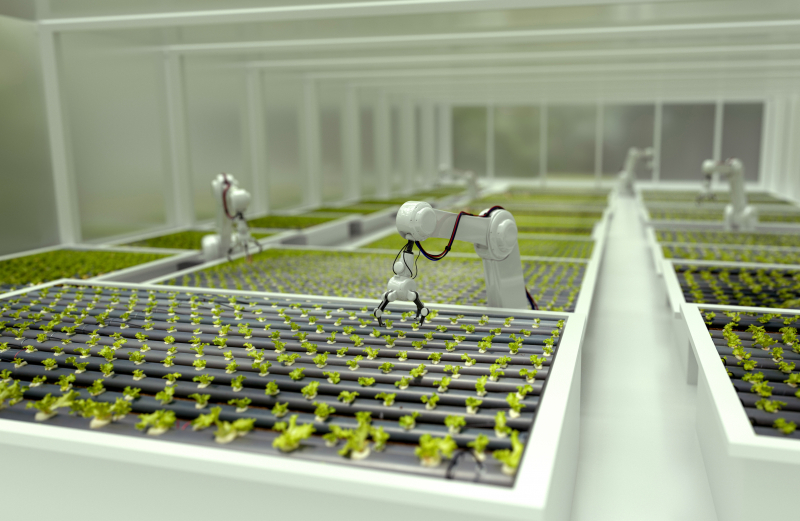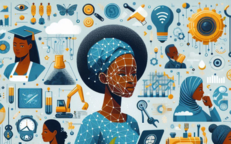Is Africa Addressing The Food Security Dilemma Through Modern Agriculture Technologies?

Authors: APET Secretariat
This post is the 10th in a blog series published in 2020 by the Secretariat on behalf of the AU High Level Panel on Emerging Technologies (APET) and the Calestous Juma Executive Dialogues (CJED).
The 4th Goal of Agenda 2063 is an Africa with “healthy and well-nourished citizens”. Currently, Africa is facing food security challenges because of increasing population, urbanization, and limited agri-food productivity. The World Vision has reported that approximately 257 million people across the continent, representing approximately 20% of the African population, are facing hunger threats. In addition, there are chronically undernourished 237 million people situated in sub-Saharan Africa region.[1] To counter this food insecurity challenge, the African Union has committed towards addressing this pressing challenge through a framework known as the Comprehensive African Agriculture Development Programme (CAADP). The CAADP is a continental agricultural framework through which all African Union (AU) Member States are encouraged to stimulate higher agri-food production to ensure food security for her increasing populations.[2],[3] Furthermore, the CAADP calls for African agricultural research institutions, farmers’ associations, African governments and the private sector to collectively develop, heighten investment, and stimulate agricultural production and growth. On the other hand, the Maputo Declaration urged AU Member States to allocate 10% of their national budgets towards agricultural activities’ investments. This 10% investment of the GDP is encouraged so to accomplish approximately 6% agriculture economic growth over the next few decades.[4]
African countries are also encouraged to adopt modern agricultural technologies in order to enhance agricultural productivity across the continent. Notably, adopting modern agricultural technologies has the potential to significantly boost African agriculture and make it more productive, competitive, sustainable, and inclusive. These modern agricultural technologies include sensors, artificial intelligence (AI) enabled and digital technology devices, automated machinery, and information technology. This includes characteristically utilising advanced technologies such as robotics, temperature and moisture sensors, aerial images from satellites and drones, and GPS technology. Adopting these innovative devices, precision agriculture, and robotic systems is enabling agri-food enterprises realize better profitability, efficiency, safety, and environmental friendliness.
Aspirations of Agenda 2063 and the Accelerated Agricultural Growth and Transformation (AAGT) - formulated by African Heads of States and Governments - aim at eradicating hunger in Africa by 2025.[5],[6] However, with such frameworks in place, Africa is still experiencing food security challenges related to food insecurity. For example, the most dominant challenge hindering achieving increased agricultural growth that could boost food self-sufficiency is inadequate agricultural research and development (R&D). Notably, robust R&D activities could enhance Africa’s agricultural innovation.[7] Thus, the lack of adequate investment towards R&D results into deficient agricultural infrastructure across the continent. Therefore, Africa’s policymakers and decision makers are encouraged to increase investments towards modern agricultural R&D and innovative activities in order address food insecurity. By increasing agri-food R&D investments, there will be accelerated harnessing of modern technologies in various agri-food aspects across the continent.[8]
Inefficient implementation of policy frameworks that address adequate food distribution mechanisms that can improve food accessibility within Africa’s increasing population growth, and address both poverty and inequality, remain a challenge for the continent. Consequently, there is limited access to food sources for numerous Africans, more especially those situated in remote and rural areas. There is also an increasingly fragmented agricultural infrastructure that hinders farmers from achieving increased productivity. Furthermore, the apparent income disparities are negatively discouraging families from obtaining adequate nutrients, more especially for rural children. Fortunately, despite these challenges, some African countries have observed rapid socio-economic growth in the past few decades.[9] This is demonstrated by the stability of macroeconomic indicators, the improved conditions of doing business, and enhanced agricultural incentives for farmers across the continent.[10] This growth presents opportunities for farmers to propel the development of the agri-food sector. This is because there is an enormous market for agri-food products across the continent and the rest of the world, coupled with varied prices based on offers and demands.
Several African countries have adopted some agri-food enabling technologies such as the 4th Industrial Revolution technologies. These include AI-enabled precision agriculture technologies, blockchain technologies, green houses, and modern livestock farming. AI-enabled technologies, and drone technologies supported by digital technologies are empowering African farmers with solutions towards land use yields and peak time for harvest, and input distribution gaps. These technologies are also helping farmers with contextual monitoring aspects that assist struggling farmers improve crop yields and counter the impacts of the climate change unpredictability imposed on crops. For example, African countries such as Kenya and Rwanda have utilised AI-enabled drone technologies to apply pesticides on crops, improve irrigation schedules and fields management.[11]
Existing technological private sector and start-up companies have developed blockchain solutions such as digital and e-commerce marketplaces, agricultural micro-lending and financing platforms, and crop insurance services. Notably, Africa is also embracing precision agriculture for food security that facilitates an efficient utilization of inputs for better output yields such as fertilizer and water. These technologies are also reducing environmental pollution and degradation. This is observed in the Western Cape Province of South Africa where farmers are using information technology to monitor deciduous fruit and grapes to enable water efficiency and climate-smart decisions.[12] Furthermore, wetting front detector sensors are enabling farmers significantly reduce irrigation frequency. For example, small-scale farmers in Mozambique, Tanzania, and Zimbabwe are doubling productivity, with reduced and well targeted irrigation processes.[13] Additionally, an efficient utilization of greenhouses are improving the continent’s produce on horticulture crops.
In conclusion, it is without doubt that sustainable intensification of modern agriculture and livestock systems could yield the most significant benefits towards supporting food security, creating wealth, employment and jobs, and enhancing intra-Africa trade, innovation, and competitiveness. Finally, for science, technology, and innovation to substantially transform agri-food systems in Africa, Member States ought to increase investments on modern agricultural technology R&D and innovation. Thus, it is time for the African continent address food security by using technologies that will enable be the world’s food basket.
Featured Bloggers – APET Secretariat
Justina Dugbazah
Lukovi Seke
Barbara Glover
Bhekani Mbuli
Chifundo Kungade
[1] The Number of People Affected By Hunger In Southern Africa ‘Will Stretch Around The World, November 7th, 2019: https://www.wvi.org/newsroom/southern-africa-hunger-emergency-response/number-people-affected-hunger-southern-africa.
[2] Africa Growth Initiative, CAADP at 10: Progress towards Agricultural prosperity: https://www.brookings.edu/wp-content/uploads/2016/06/12-CAADP.pdf.
[3] https://www.nepad.org/cop/comprehensive-africa-agriculture-development-programme-caadp.
[4] Guidelines on CAADP Country Implementation under the Malabo Declaration, April 2016: https://au.int/sites/default/files/documents/31251-doc-the_country_caadp_implementation_guide_-_version_d_05_apr.pdf.
[5] https://au.int/en/agenda2063/aspirations.
[6] Ending hunger in Africa: The elimination of hunger and food insecurity on the African by 2025: Conditions for success: https://www.nepad.org/caadp/publication/ending-hunger-africa-elimination-of-hunger-and-food-insecurity-african-2025.
[7] Calestous Juma, The New Harvest, Agricultural Innovation in Africa, 2011 by Oxford University Press, Inc., Published by Oxford University Press, Inc., New York, USA.
[8] Data-driven agriculture can solve the challenge of food security in Africa, November 2, 2020: https://news.microsoft.com/en-xm/2020/11/02/data-driven-agriculture-can-solve-the-challenge-of-food-security-in-africa/
[9] Africa is an opportunity for the world: Overlooked progress in governance and human development: https://www.brookings.edu/blog/africa-in-focus/2019/01/25/africa-is-an-opportunity-for-the-world-overlooked-progress-in-governance-and-human-development/.
[10] Africa in Agriculture: https://www.tralac.org/images/docs/6460/agriculture-in-africa-transformation-and-outlook.pdf
[11] Digital technologies in agriculture and rural areas, Status Report, Food and Agriculture Organization of the United Nations: http://www.fao.org/3/ca4985en/CA4985EN.pdf.
[12] Smart farmers, 2nd July 2020, Overcoming drought with new technology: https://www.futurefarming.com/Smart-farmers/Articles/2020/7/Overcoming-drought-with-new-technology-605859E/.
[13] Hanjra M.A., Williams T.O. (2020) Global Change and Investments in Smallholder Irrigation for Food and Nutrition Security in Sub-Saharan Africa. In: Gomez y Paloma S., Riesgo L., Louhichi K. (eds) The Role of Smallholder Farms in Food and Nutrition Security. Springer, Cham. https://doi.org/10.1007/978-3-030-42148-9_6.


